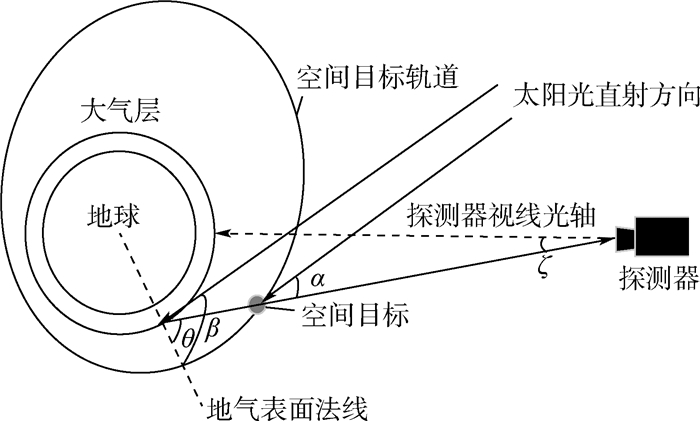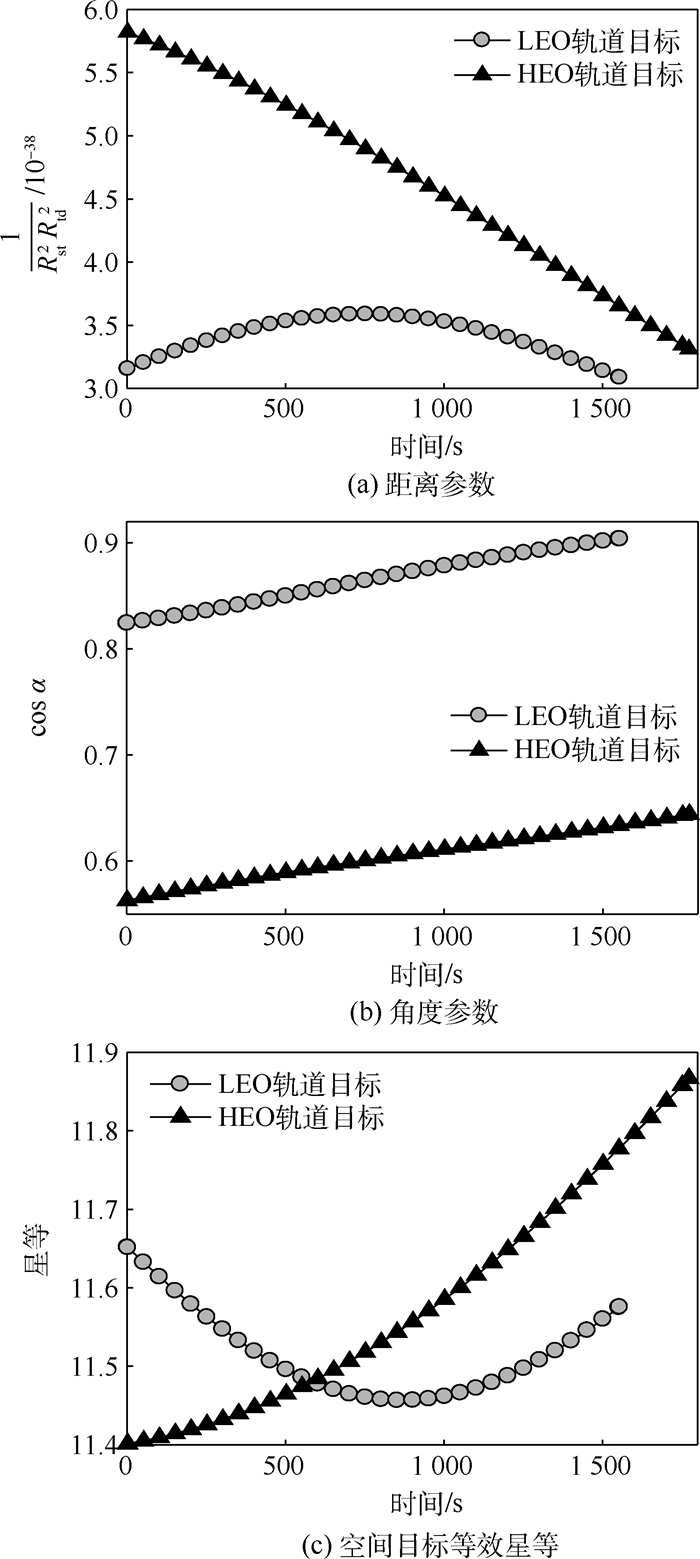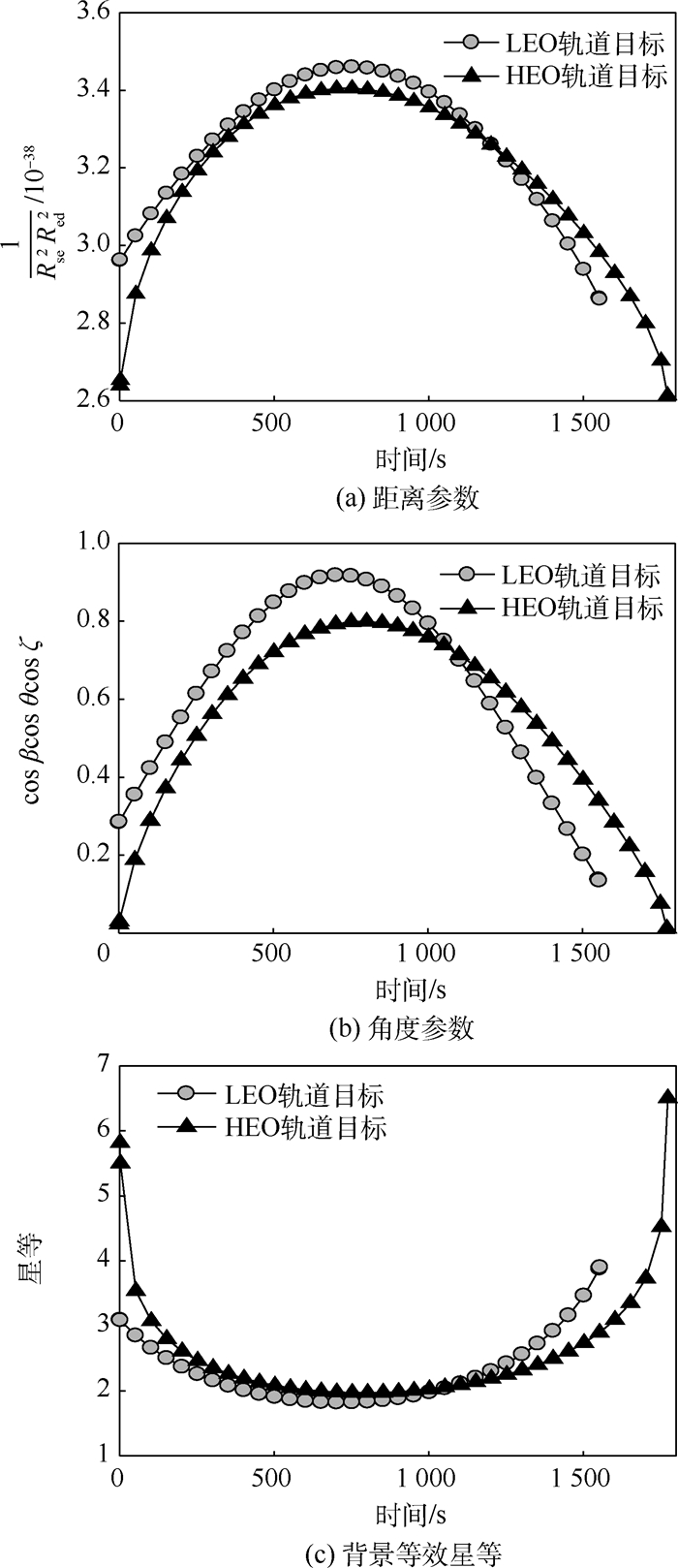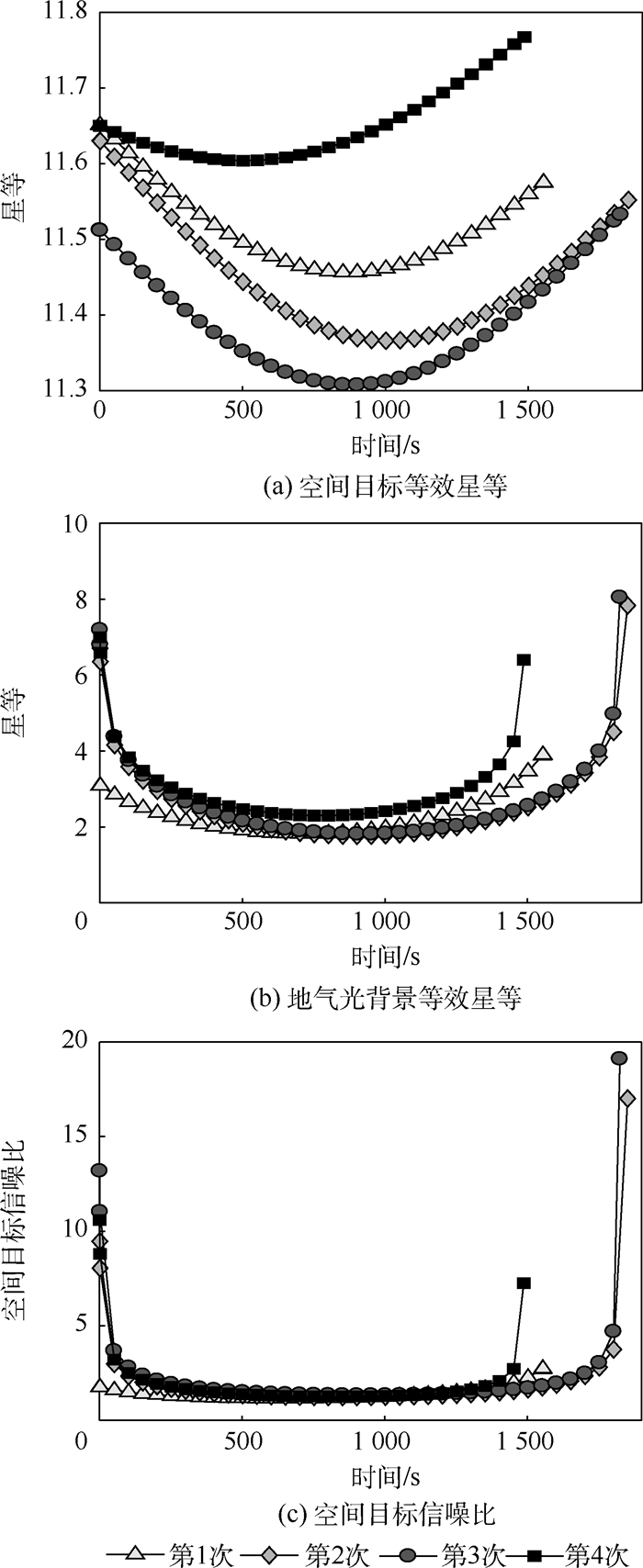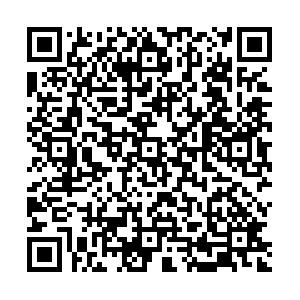-
摘要:
为分析地气光辐射对空间目标成像特性的影响,以地球同步轨道(GEO)卫星搭载的可见光成像器为探测平台,利用卫星工具包(STK)设计高椭圆轨道(HEO)及近地轨道(LEO)目标运动场景,根据空间目标、地球、太阳、探测平台之间的位置关系,采用微元法建立空间目标与地气光背景等效星等模型,推导出空间目标信噪比(SNR)计算公式。分析了距离、角度参数变化对不同轨道空间目标、地气光背景等效星等及空间目标信噪比的影响。仿真结果表明:当探测平台距离空间目标较远时,地气光背景等效星等低于空间目标等效星等,地气光辐射比空间目标信号强。当地气光辐射进入和离开空间目标探测视场时,空间目标信噪比最大,该时间段是进行空间目标探测的最佳“观测窗口”。仿真得出的空间目标信噪比值为空间目标探测识别提供了理论计算依据。
-
关键词:
- 地气光辐射 /
- 空间目标 /
- 等效星等 /
- 信噪比(SNR) /
- 卫星工具包(STK)
Abstract:To analyze the influence of earth-atmosphere radiation on imaging characteristics of space object, first, the visible light imager mounted on Geosynchronous Orbit (GEO) satellite was treated as an observation platform, and the motion scenes of Highly Elliptical Orbit (HEO) and Low Earth Orbit (LEO) objects were designed by the Satellite Tool Kit (STK). Then, the equivalent magnitude model of space object and earth-atmosphere background, and the calculation formulation for the Signal-to-Noise Ratio (SNR) of space object were derived by adopting infinitesimal method, according to the relative relationship among the space object, the sun, the earth and the observation platform. The effects of the distance and angle variables on the equivalent magnitude of different orbital objects and earth-atmosphere, as well as the SNR were analyzed. The simulation results indicate that the equivalent magnitude of earth-atmosphere background is lower than space object while the object is far away from the observation platform, which means that the earth-atmosphere radiation is stronger than the target signal. The observation window between the time when the earth-atmosphere radiation enters and leaves the target detecting field of view is the best time for target detection since the SNR is the largest. Moreover, the value of SNR obtained by simulation provides a theoretical calculation basis for the detection and recognition of space object.
-
表 1 探测系统参数
Table 1. Parameters of observation system
参数 数值 光学系统孔径/m 0.4 透过率τ 0.56 可见光谱段λ1~λ2/μm 0.3~0.9 探测器IFOV/arcsec 1.76 暗电流噪声nd 18e- 读出噪声nr 6e- 探测器对信号光的量子效率Q 0.66 曝光时间t/s 0.5 注:arcsec指弧秒,角度单位;e-表示热电子,用以表征暗电流噪声大小。 表 2 地气光辐射进入HEO轨道目标探测视场时间段
Table 2. Period when earth-atmosphere radiation enters the HEO orbit target detection field of view
地气光进入HEO轨道目标探测视场 开始时间(世界时) 结束时间(世界时) 持续时间/s 第1次 01:49:06 02:18:38 1 773 合计持续时间 1 773 表 3 地气光辐射进入LEO轨道目标探测视场时间段
Table 3. Period when earth-atmosphere radiation enters the LEO orbit target detection field of view
地气光进入LEO轨道目标探测视场 开始时间(世界时) 结束时间(世界时) 持续时间/s 第1次 02:06:38 02:32:31 1 554 第2次 03:41:56 04:12:46 1 851 第3次 05:19:42 05:50:05 1 824 第4次 06:59:37 07:24:23 1 487 合计持续时间 6 716 表 4 距离和角度参数变化
Table 4. Variation of distance and angle parameters
轨道 参数 极小值 变化规律 探测相角α 单调递减 Rtd/m 3.54×107 先减后增 Rst/m 1.489 8×1011 先减后增 LEO 光照角β 8.586 5 先减后增 出射角θ 21.427 4 先减后增 Red/m 3.607 6×107 先减后增 Rse/m 1.4901×1011 先减后增 探测相角α 单调递减 Rtd/m 2.782 5×107 单调递增 Rst/m 1.489 7×1011 单调递增 HEO 光照角β 23.523 5 先减后增 出射角θ 28.585 7 先减后增 Red/m 3.637 0×107 先减后增 Rse/m 1.490 0×1011 先减后增 表 5 两种模型空间目标等效星等数据对比
Table 5. Comparison of space target equivalent magnitude between two models
类别 HEO轨道目标等效星等均值 LEO轨道目标等效星等均值 普森公式 11.698 3 11.589 4 本文模型 11.580 5 11.513 6 差值 0.117 8 0.075 8 -
[1] YANG C P, MENG X Q, WU J. Approximate model for calculating radiance of atmospheric background[C]//4th International Symposium on Advanced Optical Manufacturing and Testing Technologies: Optical Test and Measurement Technology and Equipment. Bellingham: SPIE, 2009, 7283: 1-5. [2] 原育凯, 陈宏宇, 吴会英. 在轨航天器地气光环境分析[J]. 北京航空航天大学学报, 2011, 37(2): 136-139. https://bhxb.buaa.edu.cn/CN/Y2011/V37/I2/136YUAN Y K, CHEN H Y, WU H Y. In-orbit spacecraft's earth and atmosphere radiation environment analysis[J]. Journal of Beijing University of Aeronautics and Astronautics, 2011, 37(2): 136-139(in Chinese). https://bhxb.buaa.edu.cn/CN/Y2011/V37/I2/136 [3] 肖相国, 王忠厚, 白加光, 等. 地表反照对天基测量相机的影响[J]. 光子学报, 2009, 38(2): 375-381.XIAO X G, WANG Z H, BAI J G, et al. Influence of earth radiation on photoelectric detection system based on space[J]. Acta Photonica Sinica, 2009, 38(2): 375-381(in Chinese). [4] 张科科, 傅丹鹰, 周峰, 等. 空间目标可见光相机探测能力理论计算方法研究[J]. 航天返回与遥感, 2006, 27(4): 22-26. doi: 10.3969/j.issn.1009-8518.2006.04.005ZHANG K K, FU D Y, ZHOU F, et al. The study on detect ability calculation method of space object visible camera[J]. Spacecraft Recovery & Remote Sensing, 2006, 27(4): 22-26(in Chinese). doi: 10.3969/j.issn.1009-8518.2006.04.005 [5] 杨阳, 王宏力, 陆敬辉, 等. 地气光对星敏感器星提取精度影响分析[J]. 光电工程, 2016, 43(4): 8-14.YANG Y, WANG H L, LU J H, et al. Analysis of impact of earth and atmosphere radiation on star extraction accuracy of the star sensor[J]. Opto-Electronic Engineering, 2016, 43(4): 8-14(in Chinese). [6] 朱永生, 胡海鹰, 雷广智, 等. 利用姿态调整规避地气光的GSO空间碎片观测方法[J]. 航天器工程, 2018, 27(1): 58-66. doi: 10.3969/j.issn.1673-8748.2018.01.008ZHU Y S, HU H Y, LEI G Z, et al. Method of GSO space debris observation for suppression of earth-atmosphere radiation by using attitude guidance[J]. Spacecraft Engineering, 2018, 27(1): 58-66(in Chinese). doi: 10.3969/j.issn.1673-8748.2018.01.008 [7] 许兴星. 空间目标星载可见光相机成像仿真[D]. 北京: 中国科学院大学, 2017.XU X X. Space target spceborne visible light camera imaging simulation[D]. Beijing: University of Chinese Academy of Sciences, 2017(in Chinese). [8] 闫佩佩, 马彩文, 折文集. 地表反照光对天基空间目标的成像影响[J]. 物理学报, 2015, 64(16): 169501. doi: 10.7498/aps.64.169501YAN P P, MA C W, SHE W J. Influence of earth's reflective radiation on space target for space based imaging[J]. Acta Physica Sinica, 2015, 64(16): 169501(in Chinese). doi: 10.7498/aps.64.169501 [9] 陈荣利, 韩乐, 车驰骋, 等. 非自发光空间目标的可见光探测技术研究[J]. 光子学报, 2005, 34(9): 1438-1440.CHEN R L, HAN L, CHE C C, et al. Research on un-illuminant space target visual detection technique[J]. Acta Photonica Sinica, 2005, 34(9): 1438-1440(in Chinese). [10] 董吉辉, 胡企铨. 空间CCD凝视成像跟踪系统的作用距离分析[J]. 中国激光, 2008, 35(2): 173-177.DONG J H, HU Q Q. Analysis of working distance of CCD gaze imaging tracking system in space[J]. Chinese Journal of Lasers, 2008, 35(2): 173-177(in Chinese). [11] 欧阳桦. 基于CCD星敏感器的星图模拟和导航星提取的方法研究[D]. 武汉: 华中科技大学, 2005.OUYANG H. Research on star image simulation and star extraction method for CCD's star tracker[D]. Wuhan: Huazhong University of Science and Technology, 2005(in Chinese). [12] 蓝朝桢. 空间目标天基光学探测系统建模与探测能力分析[D]. 郑州: 解放军信息工程大学, 2009.LAN C Z. Modeling and detecting capability analysis of space-based space object optical observation system[D]. Zhengzhou: PLA Information Engineering University, 2009(in Chinese). [13] 陈维真, 张春华, 周晓东. 空间目标的光度特性及其成像信噪比研究[J]. 红外技术, 2007, 29(12): 716-719. doi: 10.3969/j.issn.1001-8891.2007.12.009CHEN W Z, ZHANG C H, ZHOU X D. A study on luminosity features and signal noise ratio of space target[J]. Infrared Technology, 2007, 29(12): 716-719(in Chinese). doi: 10.3969/j.issn.1001-8891.2007.12.009 [14] 严景文. 空间目标的光学特性分析[D]. 武汉: 华中科技大学, 2009.YAN J W. Analysis for luminosity features of space target[D]. Wuhan: Huazhong University of Science and Technology, 2009(in Chinese). [15] 张辉, 郝永杰. 基于STK的卫星星敏感器视场仿真研究[J]. 计算机仿真, 2011, 28(7): 83-86. doi: 10.3969/j.issn.1006-9348.2011.07.021ZHANG H, HAO Y J. Simulation for view field of star sensor based on STK[J]. Computer Simulation, 2011, 28(7): 83-86(in Chinese). doi: 10.3969/j.issn.1006-9348.2011.07.021 -







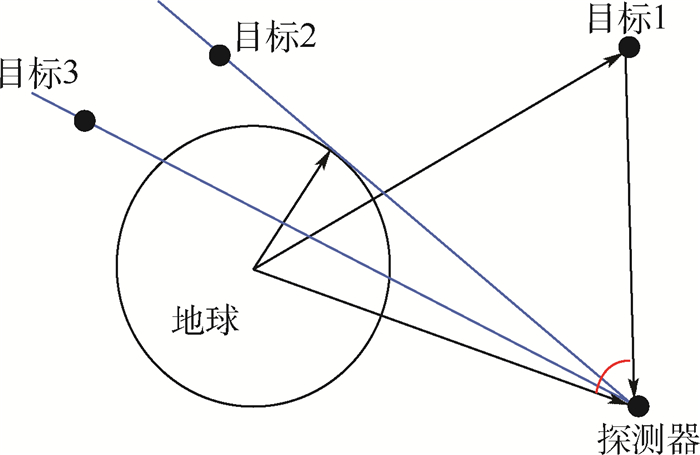
 下载:
下载:
